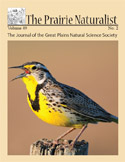Great Plains Natural Science Society

The Prairie Naturalist
Date of this Version
5-2010
Document Type
Article
Citation
The Prairie Naturalist· 42(1/2): June 2010, pp 24-31
Abstract
We assessed successional trends, long-term vegetation sustainability, and soil surface protection during the 2005-2007 growing seasons on the 32-ha Ruby Gulch Waste Rock Repository cap. The cap consisted of 150 cm of rock and soil covering a polyethylene membrane which in turn covered mining waste rock in order to prevent leaching of heavy metals and acidic water into streams. Following construction in 2003, a contractor applied a grass-forb seed mixture to provide soil-surface protection especially for steeply sloped portions of the cap. In 2005, we established 56, 1-m2 plots, and 20, 20-m transects to annually measure canopy cover, basal cover, and species diversity over three growing seasons. Our results showed a decrease in species richness, including a decline in broad-leaved plants (especially clovers [Trifolium spp.]), near disappearance ofthickspike wheatgrass (Elymus lanceolatus), and poor establishment of western wheatgrass (E. smithii). Kentucky bluegrass (Poa pratensis), fescue (including Festuca brevipila and F. ovina), intermediate wheatgrass (E. hispidus) and slender wheatgrass (E. trachycaulus) increased or remained stable. With declining diversity, species composition among plots and transects became more similar over the three-year period. A severe drought and grasshopper outbreak in 2006 likely accelerated the compositional shift. Increases in vegetative cover and litter appear adequate to prevent excessive erosion, and despite low diversity, the vegetation appears self-sustaining.
Included in
Biodiversity Commons, Botany Commons, Ecology and Evolutionary Biology Commons, Natural Resources and Conservation Commons, Systems Biology Commons, Weed Science Commons
